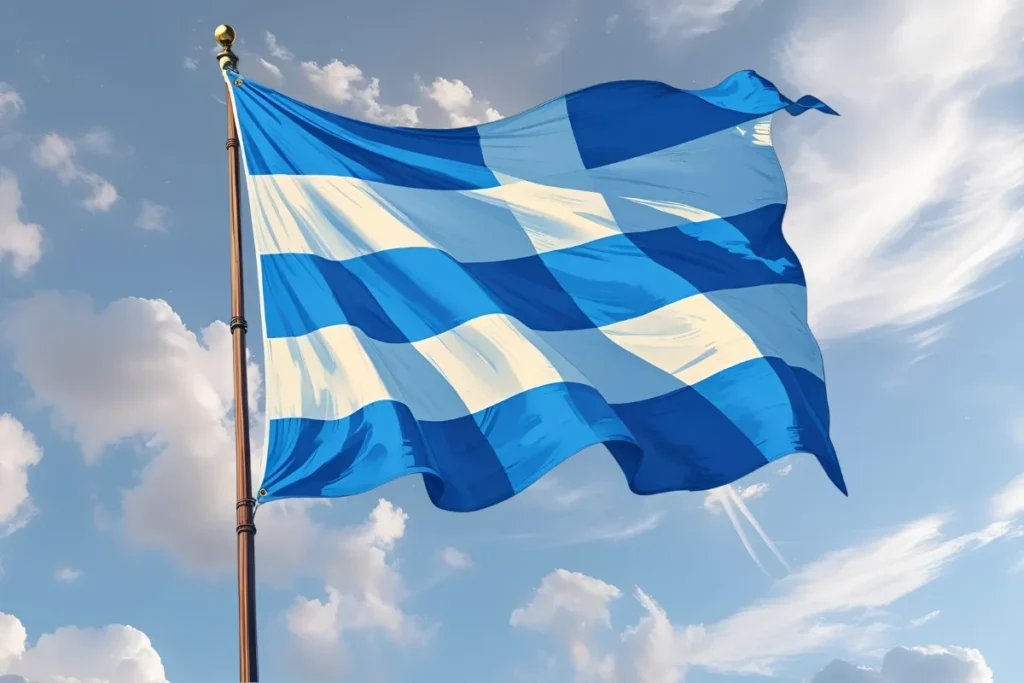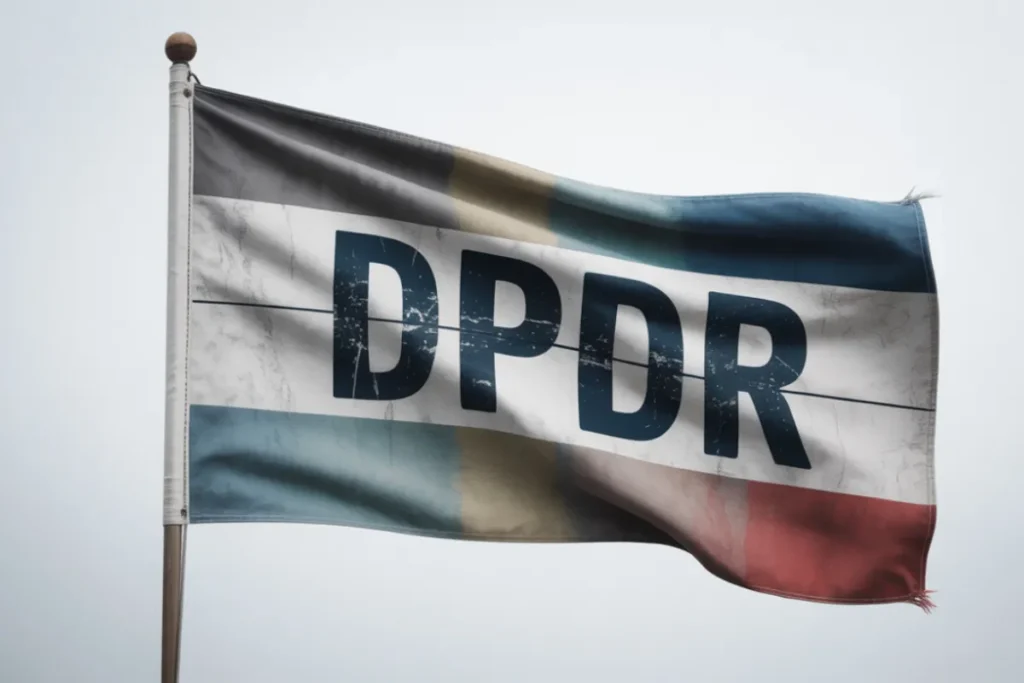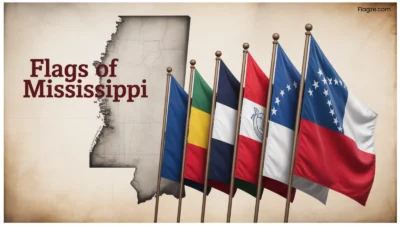Last Updated on August 18, 2025 by Mustafa Riaz
In the mental health advocacy space, symbols such as the DPDRD flag act as vital bridges toward understanding and solidarity.
More than just vibrant fabric, the DPDRD flag stands for Depersonalization-Derealization Disorder (DPDRD)—a condition where everyday life feels unreal, as if viewed through a foggy glass.
Millions live with this sense of drifting away from themselves and the world. This guide dives into the flag’s meaning, its journey into culture, and the way it sparks conversation. Whether you’re navigating DPDRD yourself or simply want to learn more, the flag shines as a shared marker of hope and healing.
The DPDRD Flag: Understanding the Symbolism and Its Meaning

The DPDRD flag translates the inner life of the condition into color and shape. Its seven horizontal stripes tell a story of drifting, reconnecting, and coming together. 🌈
- Light Blue Stripe: This fading color reflects the sense of distance, yet signals the moment the horizon opens and connection reappears.
- Bright Green Stripe: A grounding hue that stands for the small, steady actions—breath, touch, sound—that lead back to feeling real again.
These stripes and the journey they chart remind us that the feeling of drifting doesn’t have to last forever.
Color Meanings of the DPDRD Flag

- Yellow Stripe: Represents depersonalization by showing the foggy feeling of being distant from your own self.
- White Stripe (with a square): Represents a broad sense of disconnection; the square stands for the nagging sense of “something is missing” from life.
- Light Blue Stripe: Stands for derealization, where your surroundings feel fake, like a dream.
- Gray Stripe: Combines depersonalization and derealization and represents the overall feeling of being disconnected from both yourself and your surroundings.
- Black Stripe: Marks losses experienced in the disorder, such as time, feelings, or chances that slip away.
These colors turn the DPDRD flag into a powerful symbol for those championing mental health. To make it even clearer, create an infographic that shows each stripe and what it stands for, boosting interest and understanding.
Key Terms: DPDRD symbolism, depersonalization flag meaning. Discover more about DPDRD by visiting NAMI’s mental health resources.
History of the DPDRD Flag: A Story of Community
The DPDRD flag grew from mental health online spaces, beginning as a community symbol in the late 2010s.📜 Unlike flags that kings and nations adopted for centuries, this one started on Tumblr. There, people made visual designs to share what they actually felt each day.
- First Designs (2017-2018): The earliest depersonalization flags shared simple stripe patterns to show the feeling of being “not here.”
- Growth in 2022: A seven-color design appeared, adding tones to show recovery and wider dissociative feelings, and from then it connected with even more people.
Modern Variations (2023+)
Newer versions of the DPDRD flag now include colors and symbols that represent neurodivergent experiences. This reflects a growing understanding that our mental health identities are interconnected. These updated flags remind us that depersonalization and derealization don’t stand alone; they are part of a larger, shared spectrum of human experience.
Community Adoption
The flags travel quickly through social media, where they are reposted and reworked. Although no single organization created them, they have become the banners of countless awareness campaigns. Every re-share is an act of solidarity, a quiet statement that says, “I see you.” Over time, they have slipped easily into profile pictures, threads, and tapestry sales, showing that our stories can find a home wherever we share them.
Timeline of Change
The DPDRD flag has always been a living document. It changes as the culture changes. This timeline below shows how each new wave of understanding colors the original design. (Consider adding a simple timeline graphic here.)
For more on how symbols grow and spread, visit the pride flags page on Wikipedia.
Creating Your Own DPDRD Flag: A Step-by-Step Guide
Making a personal DPDRD flag is more than a craft; it can be a small act of healing. Whether you want a digital icon to keep on your phone or a fabric banner to hang on your wall, follow these steps to create one that speaks to you. 🎨
Step 1: Choose Your Base Colors
Select soft blues and grays to symbolize the feeling of distance. Introduce a lively yellow to represent the moment you become aware of that distance. Graphic design tools like Canva let you layer these colors easily.
Step 2: Incorporate Symbolism
Add a bold green stripe for steady recovery, a deep black stripe for the feelings of loss, and a central white square to show the “disconnect” you sometimes feel. Let these shapes sit side by side like heartbeats on a screen.
Step 3: Add Personal Touches
Include small, grounding symbols that mean something to you—maybe a tiny anchor or a quiet mountain. These details anchor the flag to your lived experience.
Step 4: Finalize and Share
Once you’re satisfied, save the file to your phone or print it on fabric. Display the flag on platforms like Pinterest or Instagram, and invite the community to celebrate the colors you chose.
Respectful Placement: Display the flag only in safe spaces—like therapy offices or personal awareness profiles—never in profit-driven marketing.
Digital Etiquette: You can use the design as a profile pic if you credit the artist. Always include the hashtag #DPDRDAwareness so more people can find it.
Physical Care: Keep the flag clean and free from tears. When you bring it to a gathering, share a handout with facts about the disorder.
Inclusive Sharing: Invite stories and questions, but remember that everyone’s experience is unique. Don’t pressure someone to spill details they’re not ready to share.
By following these steps, we show that we’re in this together. A graphic showing the flag hung the right way can help.
Terms: DPDRD flag etiquette, displaying depersonalization symbols. Internal link: See our guide on creating your own DPDRD flag.
The DPDRD Flag and Mental Health Awareness: A Symbol of Support and Solidarity
The DPDRD flag stands for awareness of Depersonalization-Derealization Disorder. It links people living with the disorder, showing that they are not alone and that shame has no place in recovery. 🤝 It opens the floor for honest questions and stories during awareness months.
Raising Visibility: We wave the flag at awareness events to draw attention to symptoms like feeling emotionally flat or seeing the world as dreamlike.
Community Support: Online forums use the flag graphic to let members know they are in the right place, creating a sense of kinship on hard days.
Advocacy Role: The design teams up with nonprofits that teach the public about how trauma and stress can lead to these symptoms.
Empowerment Tool: When someone shares the graphic, they’re shining a light on their experience and saying, “My story matters. You matter.”
Together, these actions keep the conversation going. An infographic showing that up to 2% of the population may experience DPDRD at some point can ride along for more impact.
Busting Myths About the DPDRD Flag
A lot of false ideas about the DPDRD flag get in the way of its good work—let’s clear them up so the flag can keep helping people. ❓
Myth: It’s just a passing trend.
Fact: The flag came from real lived experiences. It was created to keep the conversation going over years, not just days.
Myth: It’s only for people with extreme symptoms.
Fact: The flag speaks to everyone, from someone who feels a little out of their body for a few minutes to someone who feels that way daily.
Myth: It ignores other mental health issues.
Fact: It sits alongside other dissociation flags, honoring all experiences and inviting everyone in.
Myth: It has no real meaning behind the colors.
Fact: Every hue was chosen for a reason, reflecting different pieces of the condition.
When we clear up these myths, we open the door for greater understanding. Consider adding a graphic with a myth-vs-fact table for easy reference.
You might also search for “myths about the DPDRD flag” or “wrong ideas about the depersonalization flag.”
The DPDRD Flag: A Megaphone for the Overlooked
Imagine holding a megaphone that only the quietest voices can reach. That’s the DPDRD flag, calling out for everyone who feels brushed aside. 🗣️
Advocating for Fairness: It shows that the condition often tags along with trauma and that these groups—especially minorities—need extra care.
Strength in Numbers: The flag teams up with disability rights groups, making sure no one fights alone.
Personal Strength: Carrying the flag feels like joining a family, changing lonely days into group victories.
Change the World: People wave it in petitions and news stories, demanding laws and programs that actually listen to mental health needs.
For more about DPDRD and mental health, visit Mental Health America.
Be the Flag, Be the Change
Claiming public space through art can shatter silence around depersonalization. Imagine a mural the size of a bus, the DPDRD flag stretched across it—sharp ridged stripes of faded color, a ghost of a flag. Words circle the edges: “I felt less real than a reflection.” Passersby can’t ignore it. Find the prototype and paint. You are the catalyst.
Keywords: DPDRD flag for disenfranchised, depersonalization symbol advocacy.
What Comes After the Flag?
Fast-forward to the next three years and the DPDRD flag will ride the wave of stronger mental health advocacy, drifting out of subculture and into everyday view.
- Digiverse Reach: Picture the flag glowing in an app, your avatar draped in the banner’s pale, trembling stripes inside a calm VR room. You lift the flag, the colors pulse with your heartbeat.
- Global Reach: Team with organizations like Befrienders and iInclude to create a design standard: one flag, different languages, infinite locations.
- Design Play: Release bite-sized AR filters on TikTok. Swipe, and your profile pic is a mini flag with shimmering edges over your own hand.
- Research Base: Collaborate with scientists studying DPDRD: every line on the flag tied to treatment pathways, every stitch a step in the evidence.
Hold onto these threads. The next wave will bring the flag to places we cannot yet imagine.
Visualize the Future:
Click on the link to view a dreamy concept art of the flag floating through a digital sky, colors translating into soft, healing sound waves.
Terms: Future of DPDRD flag, depersonalization awareness trends.
The DPDRD Flag: A Personal Story of Hope and Healing
One person’s journey with the DPDRD flag shows how powerful it can be. ❤️ Sarah, an artist of 28, first saw the flag during a derealization episode. The world felt unreal, and, while searching for answers, she stumbled upon communities proudly carrying its bright colors. The flag felt like a lighthouse to her foggy mind, so she started making pieces that mirrored the same hazy landscape inside her. When she brought a hand-painted flag to local meetups, fellow travellers embraced it like a shared heartbeat. Each time she spoke and listened, she felt her edges slowly refocus. Now, the DPDRD flag hangs brightly in her studio, a living, waving promise that the times we feel most alone can tie us most deeply together.
This story echoes in the hearts of many in the community. Consider including a simple comic strip or hand-drawn image that traces Sarah’s journey, from fog to flag, from solitude to studio.
Keywords: DPDRD flag personal story, depersonalization healing journey.
Meta Description: (149 characters)



